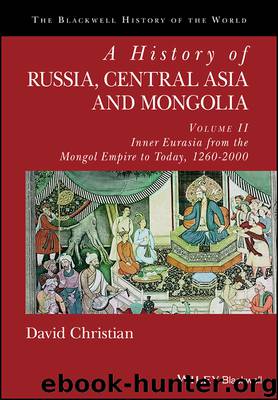A History of Russia, Central Asia and Mongolia, Volume II by David Christian

Author:David Christian
Language: eng
Format: epub
ISBN: 9781119446743
Publisher: Wiley
Published: 2018-01-04T14:30:00+00:00
In 1885 about 14 percent of cultivated land in Ferghana was devoted to cotton. By 1915, cotton accounted for 40 percent of cultivated land in Ferghana, and perhaps half of all agricultural production in Russian Central Asia.78 Transoxiana, which had long been self-sufficient in grain and rice, now had to import both crops.
Cotton production supported a growing merchant class, and the associated economic boom drove urbanization. Tashkent's population grew from c.75,000 in 1870 to almost 250,000 in 1911. By 1911, the population of Samarkand was almost 90,000, while Kokand, in the heart of the cotton-growing region, had grown to over 110,000.79 Cotton drove many rural producers into debt. In spring, when most peasants were short of cash, cotton traders or tarazudars offered loans in cash and kind (including manufactured goods or tea, soap, and paraffin) in return for a commitment to produce a fixed amount of cotton at prices determined in advance by the traders.80 Like Chinese moneylenders in Mongolia, the cotton traders were in a strong position because of their links to the imperial power, though Russian officials in the region tried hard to limit indebtedness, rightly fearing it would encourage anti-Russian feeling.
The incorporation of Central Asia's economy into the Russian mobilizational system could not have taken place without a transformation in landownership as profound as the one that Russia had undergone in 1861. In 1886, tenants of waqf lands were declared hereditary owners of the land they used, and in 1913 all tenants were given ownership of their lands.81 Combined with the introduction of local elections, these changes destroyed the authority of traditional tribal elites, and may have helped reconcile much of the local population to the new Russian authorities. But, like cotton production, they also forced traditional farmers into market relations, exposed them to debt and bankruptcy, and allowed a new concentration of landholding in the hands of new commercial elites. Cotton growing forced more and more peasants to buy their food, often at inflated prices. Increasing numbers of peasants were transformed into day-laborers, or sharecroppers, many of whom had to surrender up to 80 percent of their harvest.82
By 1900, though culturally very different from the rest of Russia, Transoxiana had been successfully incorporated into the Russian imperial mobilizational machine. The region's economic and political fate was determined increasingly by decisions taken in the Russian heartland. Yet many aspects of its traditional culture would be protected, unwittingly, by a colonial regime that was underfunded, and more interested in cotton than in cultural change.
Download
This site does not store any files on its server. We only index and link to content provided by other sites. Please contact the content providers to delete copyright contents if any and email us, we'll remove relevant links or contents immediately.
| Africa | Americas |
| Arctic & Antarctica | Asia |
| Australia & Oceania | Europe |
| Middle East | Russia |
| United States | World |
| Ancient Civilizations | Military |
| Historical Study & Educational Resources |
The Sympathizer by Viet Thanh Nguyen(4096)
The Rape of Nanking by Iris Chang(4024)
World without end by Ken Follett(3347)
Ants Among Elephants by Sujatha Gidla(3282)
Blood and Sand by Alex Von Tunzelmann(3060)
Japanese Design by Patricia J. Graham(3004)
City of Djinns: a year in Delhi by William Dalrymple(2436)
Foreign Devils on the Silk Road: The Search for the Lost Treasures of Central Asia by Peter Hopkirk(2389)
Inglorious Empire by Shashi Tharoor(2347)
The Queen of Nothing by Holly Black(2324)
In Order to Live: A North Korean Girl's Journey to Freedom by Yeonmi Park(2304)
India's Ancient Past by R.S. Sharma(2303)
Tokyo by Rob Goss(2294)
India's biggest cover-up by Dhar Anuj(2249)
Tokyo Geek's Guide: Manga, Anime, Gaming, Cosplay, Toys, Idols & More - The Ultimate Guide to Japan's Otaku Culture by Simone Gianni(2243)
The Great Game: On Secret Service in High Asia by Peter Hopkirk(2231)
Goodbye Madame Butterfly(2163)
Batik by Rudolf Smend(2009)
Living Silence in Burma by Christina Fink(1984)
